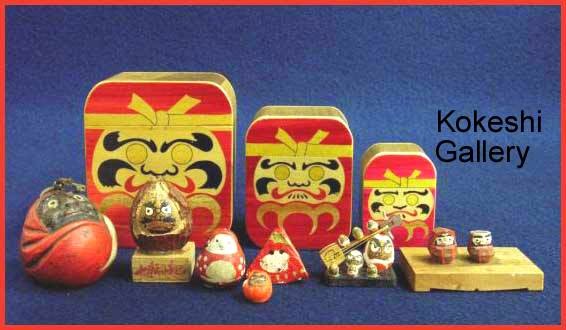:::::::::::::::::::::::::::::::::::::::::::::::::::::::::::::::::::::::::::::::::::::::::::::::::::::
Daruma from the Chichibu area, 秩父だるま
with a Gingko Leaf
Sugar dispenser in Daruma shape


- reference source : sbs.sakura.ne.jp/youkoutei/top/007syuuhen -
Chichibu Hariko Papermache Dolls - Shop
:::::::::::::::::::::::::::::::::::::::::::::::::::::::::::::::::::::::::::::::::::::::::::::::::::::
Daruma Temples in Kyoto, with Autumn leaves
especially Gingko Trees
A wonderful LINK.
http://www43.tok2.com/home/kyoto/top/kako/h12/14/daruma1.JPG
http://www43.tok2.com/home/kyoto/top/kako/h12/14/daruma2.JPG
http://www43.tok2.com/home/kyoto/top/kako/h12/index14.htm
There are more autumn leaves and temples in Kyoto, click any.
http://www43.tok2.com/home/kyoto/index.htm
ooooooooooooooooooooooooooooooooooooooooo
Now let us look at more links
************ about the Gingko biloba tree
The complete Gingko Biloba Page
(Most of my following quotes are from this quote by Cor Kwant.)
I created this site because of my fascination and respect for this unique tree, a living fossil, unchanged since the time of the dinosaurs. It is the sole living link between the lower and higher plants, a symbol of longevity and is seen as one of the wonders of this world.
Cor Kwant
http://www.xs4all.nl/~kwanten/
Gingko, the Chinese Name
Ginkgo : from the Chinese (later also Japanese) word Ginkyo meaning "silver apricot" (gin=silver, kyo=apricot). This term is thought to come from a romanized version for the Chinese ideograph Yin Hsing (Xing).
The Gingko Tree has many different names in different countries,
as you can see on the link below. Here is the Gingko World Leaf Design.
http://www.xs4all.nl/~kwanten/globe1.gif
Mandarin ducks
are regarded as love symbols in China and Japan (duck foot). (The orange brown feather -right- is called Itchoo-ba in Japan.)
Look at the ducks and read more about the name here:
http://www.xs4all.nl/~kwanten/name.htm
......................... Does it represent One living creature
......................... which has divided itself?
........................ Or are these Two, which have decided,
........................ that they should be as One?
http://www.xs4all.nl/~kwanten/birdsginkgo1.jpg
Scientists thought that it had become extinct, but in 1691 the German Engelbert Kaempfer* discovered the Ginkgo in Japan. The Ginkgos had survived in China and there they were mainly found in monestaries in the mountains and in palace and temple gardens, where Buddhist monks cultivated the tree from about 1100 AD for its many good qualities. From there it spread (by seed) to Japan (around 1192 AD with some relation to Buddhism) and Korea.
Read more about the history of this tree.
http://www.xs4all.nl/~kwanten/history.htm
*********** Medical Use
The seeds (baigo) are most used in Traditional Chinese Medicine, the leaves in western medicine. In Japan the seeds are called ginnan. The Japanese way of using Ginkgo as a medicine originates from the Chinese tradition.
Read a lot more about it.
http://www.xs4all.nl/~kwanten/history.htm
Dr. Siebold and the Gingko Tree
http://www.xs4all.nl/~kwanten/siebold.htm
The A-Bomb and the Gingko Tree,
a Bearer of Hope in Hiroshima
At the end of World War II on August 6th 1945 an atomic bomb was dropped on Hiroshima by the Americans. The plants and trees in the area around the epicentre were examined in September 1945. The Ginkgo situated near a temple about 1.1 km away from the blast center appeared to bud after the blast without any major deformations (the temple itself was destroyed).
oooooooooooooooooooooooooooooo
The Gingko Picture Gallery
Leaves in the Rain
http://www.xs4all.nl/~kwanten/photospecial.htm
Gingko Trees from all over the world, an amazing collection
http://www.xs4all.nl/~kwanten/photos.htm
Here is her Japanese selection.
http://www.xs4all.nl/~kwanten/japan.htm
oooooooooooooooooooooooooooooooooo
Famous Gingko Trees in my former hometown, Kamakura.
...................................... Shrine Tsurugaoka Hachimangu 鶴岡八幡宮
..................................... Temple Sugimoto Dera 杉本寺
..................................... Temple Hookoku-ji 報国寺
.................................... Temple Myoohon-ji 妙本寺
There are more on this link, click the right-side bottons.
http://www.geocities.co.jp/Athlete/5862/hana/ityo/ityo.html
More famous BIG Gingko in Japan
Temple Koosen-ji
http://homepage3.nifty.com/ayuboke/meisyo/kousenji.htm
In Downtown Utsunomiya
http://www.bekkoame.ne.jp/~koba-hiro/khome/ichou.html
Mountains of Iseyama
Click on the other bottons on the right for more.
Also above the picture, click on the little box on the left [次へ] to see more.
http://www.kiimr.jp/nakaheji/fukusadanoooichou/
List of big Gingko Trees in Japan
Click on anything clickable for potluck.
http://www.asahi-net.or.jp/~it8k-kjmt/kigi/listicyo.htm
菩提寺大イチョウ The one at Nagi, Temple Bodai-ji in my neighbourhood.
銀杏散る
遠くに風の
音すれば
.............................. 富安風生 Tomiyasu Fuusei Sensei
gingko chiru tooku ni kaze no oto sureba
gingko leaves fall -
far away there is
the sound of wind
Tr. Gabi Greve
© Photo Gabi Greve
Gingko at Tempel Tanjo-Ji, 2007
:::::::::::::::::::::::::::::::::::::::::::::::::::::::::::::::::::::::::::::::::::::::::::::::::::::::::::::::::::::::::::
. Chichibu no Tengu 秩父の天狗さま
The Tengu from Chichibu .
:::::::::::::::::::::::::::::::::::::::::::::::::::::::::::::::::::::::::::::::::::::::::::::::::::::::::::::::::::::::::::
[ . BACK to DARUMA MUSEUM TOP . ]
[ . BACK to WORLDKIGO . TOP . ]
:::::::::::::::::::::::::::::::::::::::::::::::::::::::::::::::::::::::::::::::::::::::::::::::::::::::::::::::::::::::::::






2 comments:
昔聞け秩父殿さへすまふとり
mukashi kike Chichibu dono sae sumootori
listen to the old stories -
even the lord of Chichibu
did some sumo wrestling
Matsuo Basho
Tr. Gabi Greve
Written about 貞亨元年, Basho age 41 or older.
Chichibu Dono refers to the samurai Hatakeyama Shigetada 畠山重忠 (1164 - 1205), who was a vassal of the famous Minamoto no Yoritomo 源頼朝 (1147 - 1199).
In the history book "kokon chomonjuu" 古今著聞集 from the Kamakura Period there is a story that he once won against the strong sumo wrestler Nagai 長居.
The circumstances why Basho picked him for his hokku is not quite clear.
.
More about Chichibu Dono
.
Chichibu no Tengu 秩父の天狗さま The Tengu from Chichibu
https://kappapedia.blogspot.jp/2017/06/tengu-from-chichibu.html
.
Post a Comment